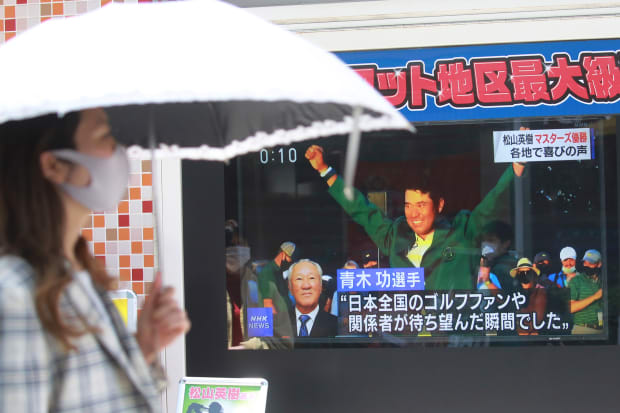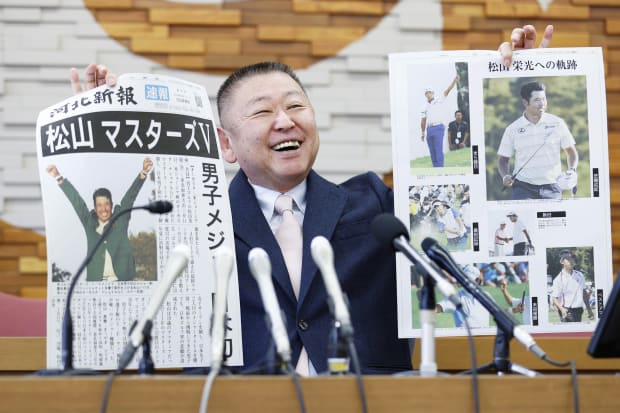In the days after the 29-year-old’s win at Augusta National, Matsuyama Mania has swept the nation, sparking a major resurgence for the whole sport
Hours after Hideki Matsuyama made history as the first pro golfer from Asia to lift the Masters trophy and wear the winner’s green jacket, the phone calls began pouring into golf shops across Japan. Everyone was eager to get their hands on just about anything that they had seen on the local hero. Did the shop have his yellow-striped Descente shirt? His Asics shoes? His Dunlop clubs, balls and cap?
“We were overwhelmed,” says Yoshiaki Yasutake, deputy manager of Victoria Golf, in downtown Tokyo’s Shinjuku district. Within 48 hours, shoppers had managed to clean out the store’s entire inventory of Matsuyama-related gear and apparel. The $920 limited-edition carrying bag, $800 clubs, $20 gloves—everything had been snapped up. “I’ve been in this business for 30 years and this was just extraordinary,” says Yasutake.
In the days after the 29-year-old’s win at Augusta National, Matsuyama Mania has swept Japan. His face has graced the front page of every major newspaper and sports tabloid. Manga artist Eiji Kazama celebrated by releasing an illustration of him. At the Tokyo Stock Exchange, shares of golf equipment and apparel makers shot up. In the halls of Parliament, the news offered politicians in ruling and opposition camps the rare chance to agree on something. On Twitter in Japan, Matsuyama became a trending phenomenon, his name dominating the 20 top-ranked hashtags. Meanwhile, in Matsuyama city—the golfer’s hometown in southwestern Japan—residents paid tribute by making the pilgrimage to a giant image of him in mid-swing at the Hideki Golf Garden, the practice range run by his father.

Matsuyama’s success in one of the sport’s most prestigious tournaments has made him a phenomenon in his homeland. While Japan remains, overall, a golf-loving nation—the sport’s stars are household names and highlights invariably make the evening news—recent years have seen a marked decline in interest. Now those around the game in the country are hoping that Matsuyama’s ascent could spur a reversal in that trend—especially since it came just three months before the Tokyo Summer Games, which will feature golf as a sport for only the fourth time.
In the 120 years since Englishman Arthur Hesketh Groom built the country’s first course in Kobe, Japan has become a breeding ground for top talent. But the Masters had long been an elusive prize. Since 1936, 33 Japanese golfers have made a combined 133 appearances at the competition, with two golfers—Toshimitsu Izawa in 2001 and Shingo Katayama in 2009—finishing as high as fourth place.
During Tokyo Broadcasting Systems’ live broadcast of the Masters, with millions of viewers tuned in early Monday morning, Matsuyama’s winning putt reduced commentator and former pro Tsuneyuki "Tommy" Nakajima to tears. “The Masters was out of our reach for so long. This is the moment that we've been waiting for,” says Daisuke Tomura, editor-in-chief of Tokyo-based Weekly Golf Digest magazine, in an interview. “It took Matsuyama 10 tries but he has proven that Japanese golfers can win at the sport’s highest level. It’s hugely symbolic.”
Golf is Japan’s third-most popular sport. It commands a solid mainstream following with weekend TV broadcasts and weekly manga. In cities across the archipelago, driving practice ranges sit atop buildings and tower alongside roads, their tall green nettings a familiar landmark. The Japanese government estimates that consumers spend ¥1.3 trillion ($12 billion) on golf equipment, apparel and green fees annually, accounting for nearly a quarter of the domestic sports market.
Traditionally, business and political elites have hit the links for entertaining and informal negotiating, a custom known as settai gorufu. But the sport has suffered since Japan’s economy went south in the late 1980s. Pricey course memberships and caddy fees, not to mention golf’s image as an old man’s pastime, have hurt the sport’s appeal. Over the past two decades, the number of people who regularly play has fallen by 50%, according to an annual survey by the Japan Productivity Center.

In recent years, Japanese course operators have adopted measures to make the sport more accessible, easing their strict dress codes and scrapping rules requiring players to hire caddies; some now even accept single-player bookings. At the 132 courses operated by the company Accordia Golf, men no longer need to wear jackets and are permitted to play in shorts if they’re matched with knee-high socks. (T-shirts and sweatpants are a no-no.) Fairway markings help with gauging distances, and flags are color-coded to indicate whether the hole is in the center of the green or on the near or far side. These days many players who prefer faster rounds can opt out of lunch in the canteen (formerly part of a required package) and, thanks to dynamic pricing, a weekday round costs a third of the standard ¥10,000 ($92) weekend price, says Accorda Golf’s spokesman Katsumi Kuroki. “We’re trying to make the cost more reasonable and affordable so people will golf more than once or twice a year.”
One sign that the efforts are paying off: In the past six months, there has been a surge of first-timers in their 20s and 30s booking tee times and signing up for lessons. “Many young people now view golf as a pandemic-friendly outdoor sport that can be played while maintaining social distance,” says Kuroki, whose company also runs more than two dozen driving ranges.
The bigger question is whether the euphoria over Matsuyama’s feat will provide the sport with a much-needed boost. In Japan, his public persona as a quiet, unflashy, hard-working everyman has won him plenty of admirers beyond the hardcore golf fan base. On Wednesday, at his first news conference since returning to Japan a day earlier, Matsuyama, who was dressed in his winning Masters green jacket, suggested that he had been unprepared for the crush of attention and adulation at home. “After coming back and reading up on the news here, it’s sinking in that I did something big,” he said in an online teleconference with reporters.
He recalled how, as a five-year-old, he had been inspired by Tiger Woods’s dominant Masters win in 1997. But unlike Woods’s emphatic fist pump, Matsuyama had stoically doffed his cap and walked off the green. “At the final hole, I didn’t raise my arms in triumph. It wasn’t a stylish ending. And the way that I came off the green was awkward,” he said. “But I’ve shown that a Japanese person can wear this green jacket. It would make me happy if kids who watched me aspire to be like me, the way I wanted to be like Tiger.”
Kenji Hall is an American journalist based in Tokyo
More Masters Coverage:
• Woods Congratulates Hideki Matsuyama on Masters Victory
• Matsuyama's Methodical Masters Approach Was an Apt Path to Victory
• Best Moments from the 2021 Masters